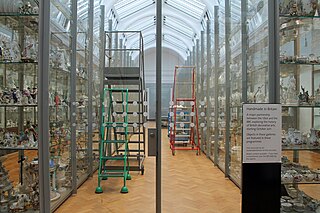
With respect to cultural property, conservation science is the interdisciplinary study of the conservation of art, architecture, technical art history and other cultural works through the use of scientific inquiry. General areas of research include the technology and structure of artistic and historic works. In other words, the materials and techniques from which cultural, artistic and historic objects are made.

The conservation and restoration of parchment constitutes the care and treatment of parchment materials which have cultural and historical significance. Typically undertaken by professional book and document conservators, this process can include preventive measures which protect against future deterioration as well as specific treatments to alleviate changes already caused by agents of deterioration.

A conservator-restorer is a professional responsible for the preservation of artistic and cultural artifacts, also known as cultural heritage. Conservators possess the expertise to preserve cultural heritage in a way that retains the integrity of the object, building or site, including its historical significance, context and aesthetic or visual aspects. This kind of preservation is done by analyzing and assessing the condition of cultural property, understanding processes and evidence of deterioration, planning collections care or site management strategies that prevent damage, carrying out conservation treatments, and conducting research. A conservator's job is to ensure that the objects in a museum's collection are kept in the best possible condition, as well as to serve the museum's mission to bring art before the public.
Polynomial texture mapping (PTM), also known as Reflectance Transformation Imaging (RTI), is a technique of imaging and interactively displaying objects under varying lighting conditions to reveal surface phenomena. The data acquisition method is Single Camera Multi Light (SCML).
Conservation and restoration of movable cultural property is a term used to denote the conservation of movable cultural property items in libraries, archives, museums and private collections. Conservation encompasses all the actions taken toward the long-term preservation of cultural heritage. Activities include examination, documentation, treatment, and preventive care, which is supported by research and education. Object conservation is specifically the actions taken to preserve and restore cultural objects. The objects span a wide range of materials from a variety of cultures, time periods, and functions. Object conservation can be applied to both art objects and artifacts. Conservation practice aims to prevent damage from occurring, a process known as 'preventive conservation'. The purpose of preventive conservation is to maintain, and where possible enhance, the condition of an object, as well as managing deterioration risks, such as handling and environmental conditions. Historically, object conservation was focused on the category of fine arts but now many different types of objects are conserved. Each type of object material, typically denoted by organic or inorganic then the specific medium, requires a specialized professional conservator and often requires collaborative work between museum staff, scientists, and conservators.

Collection maintenance is an area of collections management that consists of the day-to-day hands on care of collections and cultural heritage. The primary goal of collections maintenance or preventive conservation is to prevent further decay of cultural heritage by ensuring proper storage and upkeep including performing regular housekeeping of the spaces and objects and monitoring and controlling storage and gallery environments. Collections maintenance is part of the risk management field of collections management. The professionals most involved with collections maintenance include collection managers, registrars, and archivists, depending on the size and scope of the institution. Collections maintenance takes place in two primary areas of the museum: storage areas and display areas.

A paintings conservator is an individual responsible for protecting cultural heritage in the form of painted works of art. These individuals are most often under the employ of museums, conservation centers, or other cultural institutions. They oversee the physical care of collections, and are trained in chemistry and practical application of techniques for repairing and restoring paintings.

A conservation technician is a specialist in conservation methods pertaining to cultural property, and who may work in museums or public or private conservation organizations. A technician may also work in conjunction with other collection staff, such as a registrar (museum) or collection manager.

The conservation and restoration of books, manuscripts, documents, and ephemera is an activity dedicated to extending the life of items of historical and personal value made primarily from paper, parchment, and leather. When applied to cultural heritage, conservation activities are generally undertaken by a conservator. The primary goal of conservation is to extend the lifespan of the object as well as maintaining its integrity by keeping all additions reversible. Conservation of books and paper involves techniques of bookbinding, restoration, paper chemistry, and other material technologies including preservation and archival techniques.

An Objects conservator is a professional, working in a museum setting or private practice, that specializes in the conservation of three-dimensional works. They undergo specialized education, training, and experience that allows them to formulate and implement preventive strategies and invasive treatment protocols to preserve cultural property for the future. Objects conservators typically specialize in one type of material or class of cultural property, including metals, archaeological artifacts, ethnographic artifacts, glass, and ceramic art. Objects conservation presents many challenges due to their three-dimensional form and composite nature.

A conservation scientist is a museum professional who works in the field of conservation science and whose focus is on the research of cultural heritage through scientific inquiry. Conservation scientists conduct applied scientific research and techniques to determine the material, chemical, and technical aspects of cultural heritage. The technical information conservation scientists gather is then used by conservator and curators to decide the most suitable conservation treatments for the examined object and/or adds to our knowledge about the object by providing answers about the material composition, fabrication, authenticity, and previous restoration treatments.

Conservation and restoration of objects made from plastics is work dedicated to the conservation of objects of historical and personal value made from plastics. When applied to cultural heritage, this activity is generally undertaken by a conservator-restorer.

A photograph conservator is a professional who examines, documents, researches, and treats photographs, including documenting the structure and condition of art works through written and photographic records, monitoring conditions of works in storage and exhibition and transit environments. This person also performs all aspects of the treatment of photographs and related artworks with adherence to the professional Code of Ethics.

The conservation and restoration of Tibetan thangkas is the physical preservation of the traditional religious Tibetan painting form known as a thangka. When applied to thangkas of significant cultural heritage, this activity is generally undertaken by a conservator-restorer.

The conservation and restoration of paintings is carried out by professional painting conservators. Paintings cover a wide range of various mediums, materials, and their supports. Painting types include fine art to decorative and functional objects spanning from acrylics, frescoes, and oil paint on various surfaces, egg tempera on panels and canvas, lacquer painting, water color and more. Knowing the materials of any given painting and its support allows for the proper restoration and conservation practices. All components of a painting will react to its environment differently, and impact the artwork as a whole. These material components along with collections care will determine the longevity of a painting. The first steps to conservation and restoration is preventive conservation followed by active restoration with the artist's intent in mind.
The conservation and restoration of ancient Greek pottery is a sub-section of the broader topic of conservation and restoration of ceramic objects. Ancient Greek pottery is one of the most commonly found types of artifacts from the ancient Greek world. The information learned from vase paintings forms the foundation of modern knowledge of ancient Greek art and culture. Most ancient Greek pottery is terracotta, a type of earthenware ceramic, dating from the 11th century BCE through the 1st century CE. The objects are usually excavated from archaeological sites in broken pieces, or shards, and then reassembled. Some have been discovered intact in tombs. Professional conservator-restorers, often in collaboration with curators and conservation scientists, undertake the conservation-restoration of ancient Greek pottery.
The conservation-restoration of panel paintings involves preventive and treatment measures taken by paintings conservators to slow deterioration, preserve, and repair damage. Panel paintings consist of a wood support, a ground, and an image layer. They are typically constructed of two or more panels joined together by crossbeam braces which can separate due to age and material instability caused by fluctuations in relative humidity and temperature. These factors compromise structural integrity and can lead to warping and paint flaking. Because wood is particularly susceptible to pest damage, an IPM plan and regulation of the conditions in storage and display are essential. Past treatments that have fallen out of favor because they can cause permanent damage include transfer of the painting onto a new support, planing, and heavy cradling. Today's conservators often have to remediate damage from previous restoration efforts. Modern conservation-restoration techniques favor minimal intervention that accommodates wood's natural tendency to react to environmental changes. Treatments may include applying flexible battens to minimize deformation or simply leaving distortions alone, instead focusing on preventive care to preserve the artwork in its original state.
Cultural property imaging is a necessary part of long term preservation of cultural heritage. While the physical conditions of objects will change over time, imaging serves as a way to document and represent heritage in a moment in time of the life of the item. Different methods of imaging produce results that are applicable in various circumstances. Not every method is appropriate for every object, and not every object needs to be imaged by multiple methods. In addition to preservation and conservation related concerns, imaging can also serve to enhance research and study of cultural heritage.
The Modern and Contemporary Art Research Initiative is a program started by the Getty Conservation Institute (GCI). It began in 2007 in response to the variety of new materials and technologies being used by contemporary artists in their work, and the lack of known conservation treatments for these new materials. This area was seen as a gap in the field of conservation, but also posed unique challenges when considering the intention of the artist and the physical aging that his or her materials might endure. According to Thomas F. Reese, "Conservators...must enter into the critical spirit of the works themselves if they are to save and transmit not merely decontextualized fragments but their essence to the future."

Gold ground or gold-ground (adjective) is a term in art history for a style of images with all or most of the background in a solid gold colour. Historically, real gold leaf has normally been used, giving a luxurious appearance. The style has been used in several periods and places, but is especially associated with Byzantine and medieval art in mosaic, illuminated manuscripts and panel paintings, where it was for many centuries the dominant style for some types of images, such as icons. For three-dimensional objects, the term is gilded or gold-plated.














